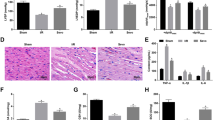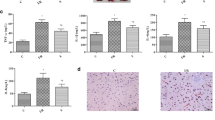Abstract
Myocardial infarction (MI) is a significant cause of death and disability, and sevoflurane (sevo) can protect myocardium in clinic. We aim to assess the effects of miR-210-3p on MI rats undergoing sevo treatment with the involvement of adenylyl cyclase type 9 (ADCY9). Rat MI models were constructed by ligation of the left anterior descending, and the modeled rats were respectively treated with sevo, miR-210-3p agomir, antagomir, or overexpressed ADCY9. Then, miR-210-3p and ADCY9 expression, cardiac function, myocardial injury and fibrosis, and cardiomyocyte apoptosis in rats were evaluated. Target relation between miR-210-3p and ADCY9 was detected. miR-210-3p was downregulated while ADCY9 was upregulated in MI rats. Sevo was able to promote cardiac function and attenuate myocardial injury and fibrosis, as well as cardiomyocyte apoptosis in MI rats. These effects of sevo were strengthened by miR-210-3p elevation but abolished by miR-210-3p inhibition in MI rats. The role of elevated miR-210-3p in MI rats was reversed by overexpression of ADCY9. Upregulated miR-210-3p improves sevo-induced protective effect on ventricular remodeling in rats with MI through inhibiting ADCY9.





Similar content being viewed by others
References
Arif M, Pandey R, Alam P, Jiang S, Sadayappan S, Paul A, Ahmed RPH (2017) MicroRNA-210-mediated proliferation, survival, and angiogenesis promote cardiac repair post myocardial infarction in rodents. J Mol Med (Berl) 95(12):1369–1385
Aydin S, Ugur K, Aydin S, Sahin I, Yardim M (2019) Biomarkers in acute myocardial infarction: current perspectives. Vasc Health Risk Manag 15:1–10
Bian WS, Shi PX, Mi XF, Sun YY, Yang DD, Gao BF, Wu SX, Fan GC (2018) MiR-210 protects cardiomyocytes from OGD/R injury by inhibiting E2F3. Eur Rev Med Pharmacol Sci 22(3):743–749
Breuer T, Maes K, Rossaint R, Marx G, Scheers H, Bergs I, Bleilevens C, Gayan-Ramirez G, Bruells CS (2015) Sevoflurane exposure prevents diaphragmatic oxidative stress during mechanical ventilation but reduces force and affects protein metabolism even during spontaneous breathing in a rat model. Anesth Analg 121(1):73–80
Cao J, Xie H, Sun Y, Zhu J, Ying M, Qiao S, Shao Q, Wu H, Wang C (2015) Sevoflurane post-conditioning reduces rat myocardial ischemia reperfusion injury through an increase in NOS and a decrease in phopshorylated NHE1 levels. Int J Mol Med 36(6):1529–1537
Curley D, Lavin Plaza B, Shah AM, Botnar RM (2018) Molecular imaging of cardiac remodelling after myocardial infarction. Basic Res Cardiol 113(2):10
Fan L, Wu Y, Wang J, He J, Han X (2019) Sevoflurane inhibits the migration and invasion of colorectal cancer cells through regulating ERK/MMP-9 pathway by up-regulating miR-203. Eur J Pharmacol 850:43–52
Ferdinandy P, Schulz R, Baxter GF (2007) Interaction of cardiovascular risk factors with myocardial ischemia/reperfusion injury, preconditioning, and postconditioning. Pharmacol Rev 59(4):418–458
Liu H, Wang J, Chen Y, Chen Y, Ma X, Bihl JC, Yang Y (2017) NPC-EXs alleviate endothelial oxidative stress and dysfunction through the miR-210 downstream Nox2 and VEGFR2 pathways. Oxid Med Cell Longev 2017:9397631
Liu AJ, Pang CX, Liu GQ, Wang SD, Chu CQ, Li LZ, Dong Y, Zhu DZ (2019) Ameliorative effect of sevoflurane on endoplasmic reticulum stress mediates cardioprotection against ischemia-reperfusion injury (1). Can J Physiol Pharmacol 97(5):345–351
Lu Y, Bu M, Yun H (2019) Sevoflurane prevents hypoxia/reoxygenation-induced cardiomyocyte apoptosis by inhibiting PI3KC3-mediated autophagy. Hum Cell 32(2):150–159
Ma H, Chen P, Sang C, Huang D, Geng Q, Wang L (2018) Modulation of apoptosis-related microRNAs following myocardial infarction in fat-1 transgenic mice vs wild-type mice. J Cell Mol Med 22(11):5698–5707
Michaud K, Basso C, d’Amati G, Giordano C, Kholova I, Preston SD, Rizzo S, Sabatasso S, Sheppard MN, Vink A et al (2020) Diagnosis of myocardial infarction at autopsy: AECVP reappraisal in the light of the current clinical classification. Virchows Arch 476(2):179–194
Montrief T, Davis WT, Koyfman A, Long B (2019) Mechanical, inflammatory, and embolic complications of myocardial infarction: an emergency medicine review. Am J Emerg Med 37(6):1175–1183
Pasculli B, Barbano R, Rendina M, Fontana A, Copetti M, Mazza T, Valori VM, Morritti M, Maiello E, Graziano P et al (2019) Hsa-miR-210-3p expression in breast cancer and its putative association with worse outcome in patients treated with Docetaxel. Sci Rep 9(1):14913
Pasqualin RC, Mostarda CT, Souza LE, Vane MF, Sirvente R, Otsuki DA, Torres ML, Irigoyen MC, Auler JO Jr (2016) Sevoflurane preconditioning during myocardial ischemia-reperfusion reduces infarct size and preserves autonomic control of circulation in rats. Acta Cir Bras 31(5):338–345
Prabhu SD, Frangogiannis NG (2016) The biological basis for cardiac repair after myocardial infarction: from inflammation to fibrosis. Circ Res 119(1):91–112
Qi Z, Li S, Su Y, Zhang J, Kang Y, Huang Y, Jin F, Xing Q (2019) Role of microRNA‐145 in protection against myocardial ischemia/reperfusion injury in mice by regulating expression of GZMK with the treatment of sevoflurane. J Cell Physiol 234(9):16526–16539. https://doi.org/10.1002/jcp.28323
Qiao SG, Sun Y, Sun B, Wang A, Qiu J, Hong L, An JZ, Wang C, Zhang HL (2019) Sevoflurane postconditioning protects against myocardial ischemia/reperfusion injury by restoring autophagic flux via an NO-dependent mechanism. Acta Pharmacol Sin 40(1):35–45
Rautureau Y, Deschambault V, Higgins ME, Rivas D, Mecteau M, Geoffroy P, Miquel G, Uy K, Sanchez R, Lavoie V et al (2018) ADCY9 (adenylate cyclase type 9) inactivation protects from atherosclerosis only in the absence of CETP (cholesteryl ester transfer protein). Circulation 138(16):1677–1692
Tan J, Wu Z, Liu J, Zhang W, Yuan W, Peng H (2020a) MicroRNA-203-mediated inhibition of doublecortin underpins cardioprotection conferred by sevoflurane in rats after myocardial ischaemia-reperfusion injury. J Cell Mol Med 24(17):9825–9838
Tan DX, Chen XX, Bai TZ, Zhang J, Li ZF (2020) Sevoflurane up-regulates microRNA-204 to ameliorate myocardial ischemia/reperfusion injury in mice by suppressing Cotl1. Life Sci 259:118162
Thygesen K, Alpert JS, White HD, E.S.C.A.A.H.A.W.H.F.T.F.f.t.R.o.M.I. Joint (2007) Universal definition of myocardial infarction. J Am Coll Cardiol 50(22):2173–95
Wang J, Zhang Y, Liu YM, Guo LL, Wu P, Dong Y, Wu GJ (2016) Huoxue anxin recipe () promotes myocardium angiogenesis of acute myocardial infarction rats by up-regulating miR-210 and vascular endothelial growth factor. Chin J Integr Med 22(9):685–690
Wang N, Chen C, Yang D, Liao Q, Luo H, Wang X, Zhou F, Yang X, Yang J, Zeng C et al (2017) Mesenchymal stem cells-derived extracellular vesicles, via miR-210, improve infarcted cardiac function by promotion of angiogenesis. Biochim Biophys Acta Mol Basis Dis 1863(8):2085–2092
Wen T, Wang L, Sun XJ, Zhao X, Zhang GW, Li-Ling J (2017) Sevoflurane preconditioning promotes activation of resident CSCs by transplanted BMSCs via miR-210 in a rat model for myocardial infarction. Oncotarget 8(70):114637–114647
Yang M, Tang X, Wang Z, Wu X, Tang D, Wang D (2019) miR-125 inhibits colorectal cancer proliferation and invasion by targeting TAZ. Biosci Rep 39(12). https://doi.org/10.1042/BSR20190193
Yuan J, Zhang Y (2020) Sevoflurane reduces inflammatory factor expression, increases viability and inhibits apoptosis of lung cells in acute lung injury by microRNA-34a-3p upregulation and STAT1 downregulation. Chem Biol Interact 322:109027
Zhang J, Wang S (2016) Effects of sevoflurane on cardiopulmonary function in patients undergoing coronary artery bypass. J Biol Regul Homeost Agents 30(4):1079–1083
Zhang X, Li M, Sun G, Bai Y, Lv D, Liu C (2020) MiR-563 restrains cell proliferation via targeting LIN28B in human lung cancer. Thorac Cancer 11(1):55–61
Zhong L, Jia J, Ye G (2020a) Rian/miR-210-3p/Nfkb1 feedback loop promotes hypoxia-induced cell apoptosis in myocardial infarction through deactivating the PI3K/Akt signaling pathway. J Cardiovasc Pharmacol 76(2):207–215
Zhong H, Chen H, Gu C (2020b) Sevoflurane post-treatment upregulated miR-203 expression to attenuate cerebral ischemia-reperfusion-induced neuroinflammation by targeting MyD88. Inflammation 43(2):651–663
Zhu J, Lu K, Zhang N, Zhao Y, Ma Q, Shen J, Lin Y, Xiang P, Tang Y, Hu X et al (2018) Myocardial reparative functions of exosomes from mesenchymal stem cells are enhanced by hypoxia treatment of the cells via transferring microRNA-210 in an nSMase2-dependent way. Artif Cells Nanomed Biotechnol 46(8):1659–1670
Author information
Authors and Affiliations
Corresponding author
Ethics declarations
Conflict of interest
The authors declare no competing interests.
Additional information
Publisher's note
Springer Nature remains neutral with regard to jurisdictional claims in published maps and institutional affiliations.
Supplementary Information
Below is the link to the electronic supplementary material.
Rights and permissions
About this article
Cite this article
Wu, Y., Wang, T., Qiao, L. et al. Upregulated microRNA-210-3p improves sevoflurane-induced protective effect on ventricular remodeling in rats with myocardial infarction by inhibiting ADCY9. Funct Integr Genomics 22, 279–289 (2022). https://doi.org/10.1007/s10142-021-00816-6
Received:
Revised:
Accepted:
Published:
Issue Date:
DOI: https://doi.org/10.1007/s10142-021-00816-6




